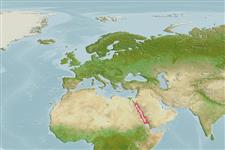Environment: milieu / climate zone / intervalo de profundidade / distribution range
Ecologia
marinhas associadas(os) a recifes; não migratória; intervalo de profundidade 15 - 50 m (Ref. 5222), usually 15 - 50 m (Ref. 89707). Tropical; 31°N - 16°N, 33°E - 43°E (Ref. 5222)
Western Indian Ocean: known only in the Red Sea, from Eilat in the northern Gulf of Aqaba to the Farasan Islands off the southern end of Saudi Arabia.
Length at first maturity / Tamanho / Peso / Idade
Maturidade: Lm 18.0, range 17 - 19 cm
Max length : 30.0 cm TL macho/indeterminado; (Ref. 5222)
Descrição breve
Chaves de identificação | Morfologia | Morfometria
Espinhos dorsais (total) : 9; Raios dorsais moles (total) : 14 - 15; Espinhos anais: 3; Raios anais moles: 9. Distinguished by having the following characteristics: depth of body 2.6-3.0 in SL; head length 2.4-2.6 in SL; slightly convex interorbital area, width equal to orbit diameter on a fish of 19 cm SL; rounded preopercle, finely serrate posteriorly, lower edge more coarsely serrate; subopercle and interopercle completely serrate; maxilla reaches well past eye (Ref. 089707).
Body shape (shape guide): fusiform / normal; Cross section: oval.
Inhabits dead reefs in silty areas as well as silty lagoons; often found in or near caves as adults, while juveniles are more common in coral rubble areas (Ref. 089707). It could possibly be an aquarium novelty. Ripe females at 17 to 19 cm SL and a mature male at 22 cm SL were reported (Ref. 6699).
Life cycle and mating behavior
Maturidade | Reprodução | Desova | Ovos | Fecundidade | Larvas
Heemstra, P.C. and J.E. Randall, 1993. FAO Species Catalogue. Vol. 16. Groupers of the world (family Serranidae, subfamily Epinephelinae). An annotated and illustrated catalogue of the grouper, rockcod, hind, coral grouper and lyretail species known to date. Rome: FAO. FAO Fish. Synop. 125(16):382 p. (Ref. 5222)
Categoria na Lista Vermelha da IUCN (Ref. 130435: Version 2025-1)
Ameaça para o homem
Harmless
Utilização humana
Pescarias: sem interesse; Aquário: Potencial
Ferramentas
Relatórios especiais
Descarregue XML
Fontes da internet
Estimates based on models
Preferred temperature (Ref.
123201): 24.5 - 29.4, mean 28.9 °C (based on 56 cells).
Phylogenetic diversity index (Ref.
82804): PD
50 = 0.5000 [Uniqueness, from 0.5 = low to 2.0 = high].
Bayesian length-weight: a=0.01259 (0.00587 - 0.02699), b=3.04 (2.87 - 3.21), in cm total length, based on LWR estimates for this Genus-body shape (Ref.
93245).
Nível Trófico (Ref.
69278): 4.0 ±0.7 se; based on size and trophs of closest relatives
Resiliência (Ref.
120179): Médio, tempo mínimo de duplicação da população 1,4 - 4,4 anos (Preliminary K or Fecundity.).
Fishing Vulnerability (Ref.
59153): Low vulnerability (20 of 100).
🛈
